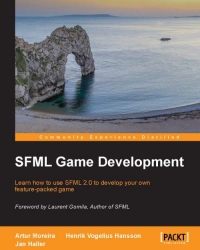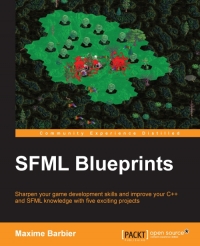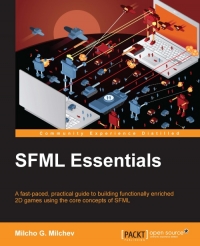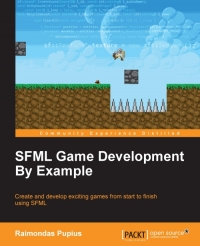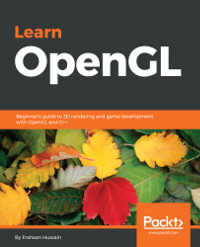SFML Game Development
Game development comprises the combination of many different aspects such as game logics, graphics, audio, user input, physics and much more. SFML is an Open Source C++ library designed to make game development more accessible, exposing multimedia components to the user through a simple, yet powerful interface. If you are a C++ programmer with a stack of ideas in your head and seeking a platform for implementation, your search ends here. Starting with nothing more than a blank screen, SFML Game Development will provide you with all the guidance you need to create your first fully featured 2D game using SFML 2.0. By the end, you'll have learned the basic principles of game development, including advanced topics such as how to network your game, how to utilize particle systems and much more. ...
Game development comprises the combination of many different aspects such as game logics, graphics, audio, user input, physics and much more. SFML is an Open Source C++ library designed to make game development more accessible, exposing multimedia components to the user through a simple, yet powerful interface. If you are a C++ programmer with a stack of ideas in your head and seeking a platform for implementation, your search ends here. Starting with nothing more than a blank screen, SFML Game Development will provide you with all the guidance you need to create your first fully featured 2D game using SFML 2.0. By the end, you'll have learned the basic principles of game development, including advanced topics such as how to network your game, how to utilize particle systems and much more. ...
SFML Blueprints
SFML is a cross-platform software development library written in C++ with bindings available for many programming languages. This book contains useful information that you'll need to create any kind of 2D games. Starting with the basics of game programming, resource management, and building simple 2D games, you'll then delve into more complex features such as the physics engine, constructing a game UI, and more advanced concepts of 2D gaming using SFML. You'll develop advanced functionality in your game using the concept of multithreading and learn how various threads interact. In later chapters, you'll quickly grasp the usage and implementation of isometric views and image transformation in your 2D real time tower defense game. You'll wrap up by adding networking and database management systems to your game with SQLite using an ORM. ...
SFML is a cross-platform software development library written in C++ with bindings available for many programming languages. This book contains useful information that you'll need to create any kind of 2D games. Starting with the basics of game programming, resource management, and building simple 2D games, you'll then delve into more complex features such as the physics engine, constructing a game UI, and more advanced concepts of 2D gaming using SFML. You'll develop advanced functionality in your game using the concept of multithreading and learn how various threads interact. In later chapters, you'll quickly grasp the usage and implementation of isometric views and image transformation in your 2D real time tower defense game. You'll wrap up by adding networking and database management systems to your game with SQLite using an ORM. ...
SFML Essentials
SFML is a cross-platform, object-oriented multimedia API that is written in C++. It provides a simple interface to ease the development of games and multimedia applications. This book will guide you through everything you need to know about building a 2D game in SFML. Concepts such as Sprites, Textures, Animation, and Cameras are explored in depth and finally the book ends with advanced topics like shaders and networking. You will also learn how to play sound and music on top of the gameplay. Every step through the journey is filled with examples in C++ to guide you in the right direction. By the end of the book you will feel confident about creating 2D games with SFML, without investing too much time on it. This book contains a set of fast-paced tutorials about the core features of SFML. ...
SFML is a cross-platform, object-oriented multimedia API that is written in C++. It provides a simple interface to ease the development of games and multimedia applications. This book will guide you through everything you need to know about building a 2D game in SFML. Concepts such as Sprites, Textures, Animation, and Cameras are explored in depth and finally the book ends with advanced topics like shaders and networking. You will also learn how to play sound and music on top of the gameplay. Every step through the journey is filled with examples in C++ to guide you in the right direction. By the end of the book you will feel confident about creating 2D games with SFML, without investing too much time on it. This book contains a set of fast-paced tutorials about the core features of SFML. ...
SFML Game Development By Example
Simple and Fast Multimedia Library (SFML) is a simple interface comprising five modules, namely, the audio, graphics, network, system, and window modules, which help to develop cross-platform media applications. By utilizing the SFML library, you are provided with the ability to craft games quickly and easily, without going through an extensive learning curve. This effectively serves as a confidence booster, as well as a way to delve into the game development process itself, before having to worry about more advanced topics such as “rendering pipelines” or “shaders.” With just an investment of moderate C++ knowledge, this book will guide you all the way through the journey of game development. The book starts by building a clone of the classical snake game where you will learn how to open a window and render a basic sprite, write well-structured code to implement the design of the game, and use the AABB bounding box collision concept. ...
Simple and Fast Multimedia Library (SFML) is a simple interface comprising five modules, namely, the audio, graphics, network, system, and window modules, which help to develop cross-platform media applications. By utilizing the SFML library, you are provided with the ability to craft games quickly and easily, without going through an extensive learning curve. This effectively serves as a confidence booster, as well as a way to delve into the game development process itself, before having to worry about more advanced topics such as “rendering pipelines” or “shaders.” With just an investment of moderate C++ knowledge, this book will guide you all the way through the journey of game development. The book starts by building a clone of the classical snake game where you will learn how to open a window and render a basic sprite, write well-structured code to implement the design of the game, and use the AABB bounding box collision concept. ...
Learn OpenGL
Learn OpenGL is your one-stop reference guide to get started with OpenGL and C++ for game development. From setting up the development environment to getting started with basics of drawing and shaders, along with concepts such as lighting, model loading, and cube mapping, this book will get you up to speed with the fundamentals. You begin by setting up your development environment to use OpenGL on Windows and macOS. With GLFW and GLEW set up using absolute and relative linking done, you are ready to setup SDL and SFML for both the operating systems. Now that your development environment is set up, you'll learn to draw using simple shaders as well as make the shader more adaptable and reusable. Then we move on to more advanced topics like texturing your objects with images and transforming your objects using translate, rotate and scale. With these concepts covered, we'll move on to topics like lighting to enable you to incorporate amazing dynamic lights in your game world. B ...
Learn OpenGL is your one-stop reference guide to get started with OpenGL and C++ for game development. From setting up the development environment to getting started with basics of drawing and shaders, along with concepts such as lighting, model loading, and cube mapping, this book will get you up to speed with the fundamentals. You begin by setting up your development environment to use OpenGL on Windows and macOS. With GLFW and GLEW set up using absolute and relative linking done, you are ready to setup SDL and SFML for both the operating systems. Now that your development environment is set up, you'll learn to draw using simple shaders as well as make the shader more adaptable and reusable. Then we move on to more advanced topics like texturing your objects with images and transforming your objects using translate, rotate and scale. With these concepts covered, we'll move on to topics like lighting to enable you to incorporate amazing dynamic lights in your game world. B ...
